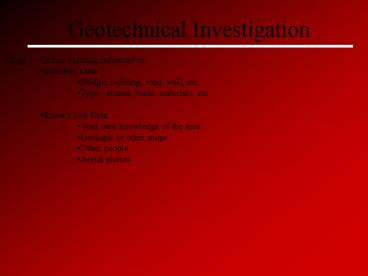Geotechnical Investigations - PowerPoint PPT Presentation
1 / 13
Title:
Geotechnical Investigations
Description:
Site Recon -Before you move any equipment to site, visit the site ... Borings used to obtain samples at various depths. Samples needed depend on project ... – PowerPoint PPT presentation
Number of Views:283
Avg rating:3.0/5.0
Title: Geotechnical Investigations
1
Geotechnical Investigation
- Step 1 - Gather Existing Information
- Structure Data
- Bridge, building, road, wall, etc.
- Type - stories, loads, materials, etc
- Known Soil Data
- Your own knowledge of the area
- Geologic or other maps
- Other people
- Aerial photos
2
Geotechnical Investigation
- Step 2 - Field Investigation
- Site Recon -Before you move any equipment to
site, visit the site - A visual inspection can tell you a lot
- Site access
- existing structures
- evidence of old structures
- environmental hazards
- non-engineered fill
- sinkholes
- topography
- condition of nearby structures
3
Geotechnical Investigation
- Step 2 - Field Investigation - contd
- Subsurface Investigation
- Test Pits - holes dug with a backhoe
- Borings
- Solid Flight
- Hollow Stem
- Rotary Wash
4
Geotechnical Investigation
- Step 2 - Field Investigation - contd
- Borings used to obtain samples at various depths
- Samples needed depend on project
- Most common method of sampling is the
- Standard Penetration Test - SPT
- Recall SPT is 140 lb hammer dropped 30
5
Geotechnical Investigation
- Borings - contd
- Drill rig Hollow Stem Auger - SPT
6
Geotechnical Investigation
- Borings - contd
- Drill rig Hollow Stem Auger - SPT
7
Geotechnical Investigation
- Borings - contd
- Drill rig Hollow Stem Auger - SPT
8
Geotechnical Investigation
- Borings contd
- of borings project dependent
- For a building, will typically start with corners
and in the middle - Based on what is found, more borings can be
drilled as needed to define areas of concern or
to obtain additional data
9
Geotechnical Investigation
- Borings contd
- Layout depends on footprint too
- Depth depends on anticipated soil conditions and
foundation type - We want to be sure we sample all soil potentially
influenced by the foundation system
10
Geotechnical Investigation
- Borings What are we looking for?
- Soil classification
- Soft compressible soils
- Competent foundation soils
- Bedrock
- Ground water
- Any other subsurface that could affect the project
11
Geotechnical Investigation
- Step 3 Laboratory Investigation
- Most common tests include
- Plasticity (atterbergs)
- Sieve
- Moisture
- Unit Weight
- Proctor
- Strength tests (unconfined, direct shear, etc.)
12
Geotechnical Investigation
- Step 4 Design
- The design process will take into account all
data - Consider loads, soils, type and use of facility,
etc. - GE often asks what is needed vs. what is
calculated
13
Geotechnical Investigation
- Step 4 Design contd
- Some of the main items conveyed to client
- Types of soils
- Groundwater
- Recommended foundation type or options plus
design and construction criteria - Depth to bedrock
- Excavatability
- Soil compaction criteria
- Slope recommendations
- Retaining wall design
- Boring and Lab test results































